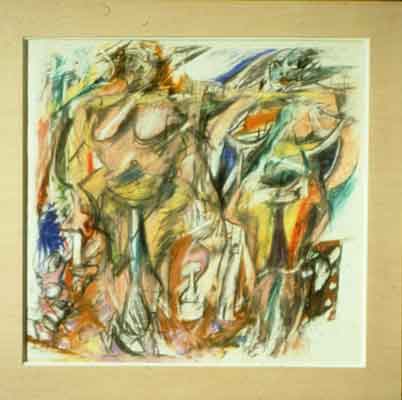This is not strictly a mental or aesthetic,
that is to say "abstract," process, but one that is crucially and inevitably
visual, concerned with visual reality). De Kooning is above all a visual (intellectual)
artist. What he sees - bodies, parts of bodies, shadows, chairs, windows, letters,
etc. - enters into an arrangement that belongs to him, but also to the world.
There is nothing that has not entered this way. If you look at a knee, everything
else around it changes, as then so does the knee. Rectangles are not just rectangles
but windows or spaces between chairs and legs. Real objects are constantly hitting
the eye, as though we were in a moving car. The principle of organization is
in the drawing or painting. Eventually, as Hess pointed out, the shapes de Kooning
has confronted, along with lines, colors, and brushstrokes, become part of a
vocabulary with which the artist struggles to make something that is incoherently
coherent, that is real. The degree of abstraction is perhaps confusing, but,
despite the artist's discovery of "no-environment," his specificity of place
and of form is far greater than in any Cubist work.
But rather quickly place drops away and we are
faced with woman herself, her flesh and mouth and vagina and breasts, far more
than we ever have been in the past, even in Rembrandt or Manet or Picasso, not
least because everything is active and clashing. It is part of our reality, not
some other mythological or voyeuristic reality. Sexuality becomes increasingly
insistent from 1950 on. The women themselves expand to fill the surface. Breasts,
hips, and eyes expand. Faces become more masklike and, in drawings such as Two
Women of 1951, almost disappear. Marilyn Monroe makes a brief appearance,
as do mouths of women cut from magazines and pasted on to de Kooning's drawn
or painted faces. Now these humans have fully become creatures of the artist's
(very fast and very commandeering) movements of line and paint. In the guise
of billboard bombshells, they are like ancient deities, as de Kooning sometimes
thought of them, staring at us from the deep past.
Perhaps too deep in the past. Eventually, paint
itself takes over, as can be seen in several passages of Two Women with Still
Life of 1952, and particularly in the single figures like Woman (Blue
Eyes) of 1953. His landscape-like abstractions of the late 1950s are totally
composed of brushstrokes, and women, for the moment, disappear. But not for long.
When the artist moved from New York City to the country (Easthampton at the end
of Long Island), they re-emerged in a new place and a new light.
I don't know why the subtitle "Tracing the Figure"
was used. To emphasize that de Kooning was a figurative painter, I suppose, in
this age of computable figuration. He did do drawings on tracing paper, a couple
of which are included in this show, sometimes to try out ideas, but the implication
of tracing figures is misleading. The exhibition itself, however, is extraordinary.
Donald Goddard © 2001
|

